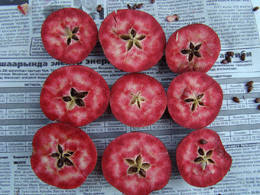- GFAR publishes list of Megaprogramme (or whatever they are called) consultations.
- Cuba’s Miscellaneous Crops Under-delegate Rolando Macias Cardenas reports on tomato paste. In other news, Cuba has a Miscellaneous Crops Under-delegate. No, wait, that’s not really news.
- While Sachs et al. moan about better agricultural data, CIAT go out and get it.
- The Pavlovsk TweetMedvedev campaign rolls on.
- “…maximum diversity can be conserved at an intermediate level of income” in Javanese bamboo-tree homegardens.
- Right, so trees “farm” bacteria. What some people will write in a press release.
- Thailand’s rice farmers trying to cope with climate change. Like they have a choice.
Not the world’s first red apple
Of course it is tiresome for you, Dear Reader, to have to wade through me correcting the mainstream media, but when duty calls I am powerless to refuse.
The BBC was all breathless a couple of days ago with news of a new apple variety on sale in England that has red flesh. Oooh. Ah. It’s like a tomato! And a large chunk of the little report was taken up by the breeder explaining that no GM was involved, just 15 years of crosses and selection and 20,000 seedlings rejected in favour of three that made the grade as worthwhile varieties. 1
 What really struck me, though, was not the utter imbecility of the reporter, or even what the bloody apple looked like. It was the fact that nobody had seemed to ask whether this was in fact the world’s first red-fleshed apple, as reported by FOXNews and The Daily Mail. 2 It isn’t that there are some wild red-fleshed apples out there, and this is the first one that’s good to eat. There have even been a fair number of commercial, good to eat, red-fleshed varieties. It’s just that reporters swallow rubbish so uncomplainingly. Google is your friend.
What really struck me, though, was not the utter imbecility of the reporter, or even what the bloody apple looked like. It was the fact that nobody had seemed to ask whether this was in fact the world’s first red-fleshed apple, as reported by FOXNews and The Daily Mail. 2 It isn’t that there are some wild red-fleshed apples out there, and this is the first one that’s good to eat. There have even been a fair number of commercial, good to eat, red-fleshed varieties. It’s just that reporters swallow rubbish so uncomplainingly. Google is your friend.
The photo (by Kayirkul Shalpykov, Bioresource, and lifted from the Living on Earth website) is of “Niedzwetzky apples (malus niedzwetzkyana), famous for their red flesh. There are 111 known trees left in the world”. Not sure I believe that either.
Nibbles: Plant breeding book, Ug99, NGS, Monitoring, Genetic diversity and productivity, Adaptive evolution, Amaranthus, Nabhan, Herbarium databases, Pepper, Shade coffee and conservation, Apples, Pathogen diversity, Phytophthora
- Book on history of plant breeding reviewed.
- Rust never sleeps.
- Ask not what next generation sequencing can do for you.
- Long-term datasets in biodiversity research. Nothing about genetic diversity though. Bummer.
- And genetic diversity is important, is it? Yep, it increases productivity, at least in Arabidopsis.
- No evidence of adaptive evolution in plants. What? Surely some mistake? I’m serious. And don’t call me Shirley.
- The latest from Worldwatch on African leafy veggies. Again, some links would have been nice.
- And Worldwatch also interviews Gary Nabhan on Vavilov.
- You can browse Tropicos specimens in Google Earth.
- Using pepper to protect stored rice.
- More evidence of the goodness of shade coffee.
- The diversity of Bosnian apples.
- Mammal plus bird species richness explains 72% of country-to-country variation in the number of human pathogens. Diversity begets diversity. But which way does the causality go?
- Phytophthora infestans in Estonia: “…higher proportion of metalaxyl resistant isolates from large conventional farms than from small conventional farms or from organic farms.” Metalaxyl is a fungicide.
Nibbles: Beer and fungus, Maize breeding, Coconut on the Salalah plain, Zen, Camel, Grazing, Berries
- Beer with shrooms. Well, not quite, but one can hope.
- No more corn detasseling? Say it ain’t so.
- “Oman to Plant 100,000 Coconut Trees in Dhofar.” That’s in the south of the country, a fascinating area. And one asks, as ever: What varieties, and what’s going to happen to the local material?
- Be like the bamboo, man.
- From DAD-Net, news of a mini-conference on the camel. And an article on same.
- The struggle for forest grazing rights in India.
- Dump blueberries, eat local berries, Brits told. Pavlovsk still in trouble.
Nibbles: Protected area management, Yam domestication, Ottoman cooking, Measuring rice drought tolerance, Proteomics, Lupinus, Areca, Jethobudho, Nutrition megaprogramme, Soil bacteria
- Concentrating management practices on conserving a particular plant species may have bad consequences for other bits of biodiversity. Lessons for crops wild relatives?
- Benin’s farmers ennoble wild yams.
- A Lebanese lunch is an educational experience. Right.
- Paddyomics video. Nothing to do with the Irish. It’s about how IRRI is automating, er, everything about its phenotyping.
- Tamarind’s environmental niche is, in fact, er, niches?
- Different wheat genomes generate distinct protein profiles.
- Phylogenetic relationships of a new Mediterranean lupin.
- Betel nut chewing endangers coral. Kinda. Traditional and all that, but an unpleasant habit nonetheless.
- Our friend Bhuwon and others tell the story of the participatory improvement and formal release of Jethobudho rice landrace in Nepal.
- CGIAR elicits comment on the Agriculture for Improved Nutrition and Health megaprogramme. Until August 1.
- Bacterial diversity boosts maize yields.